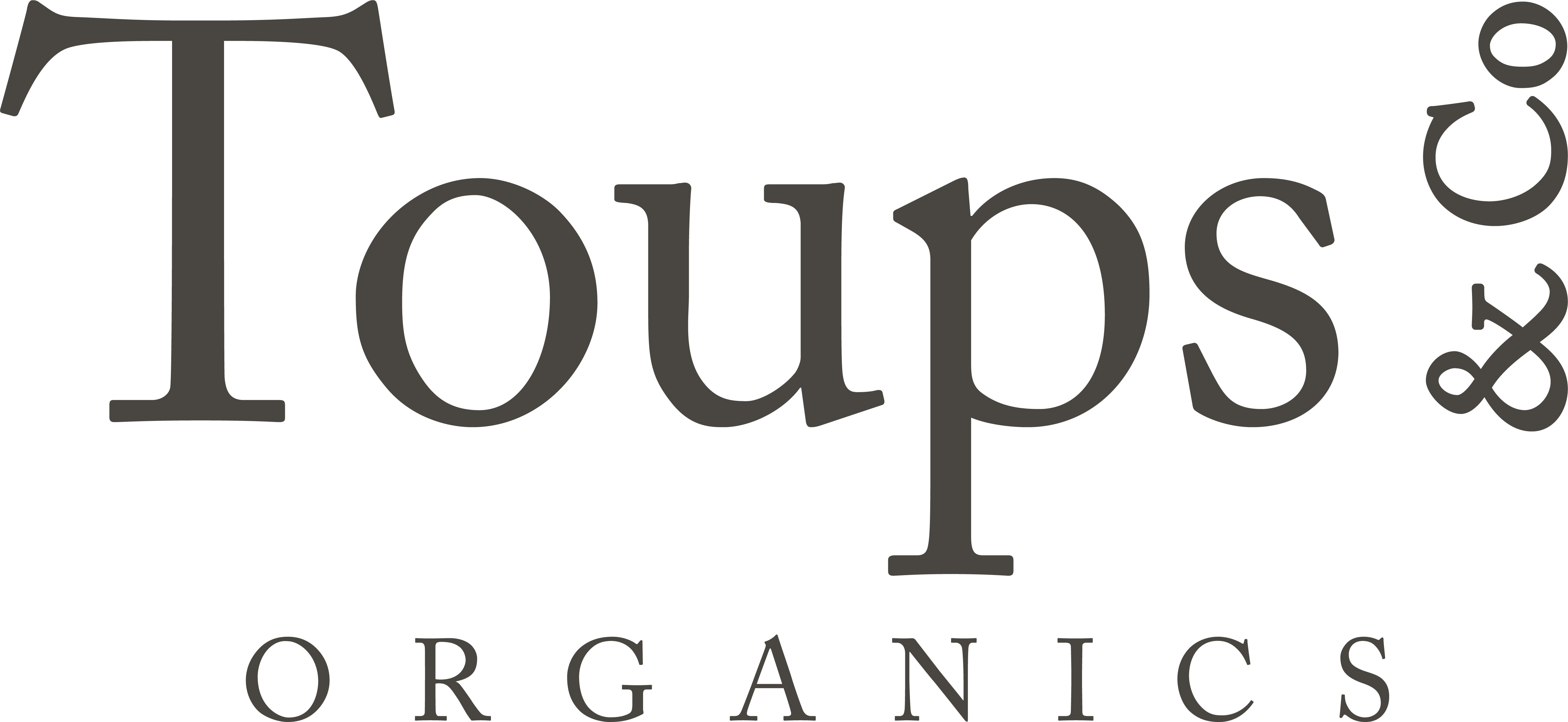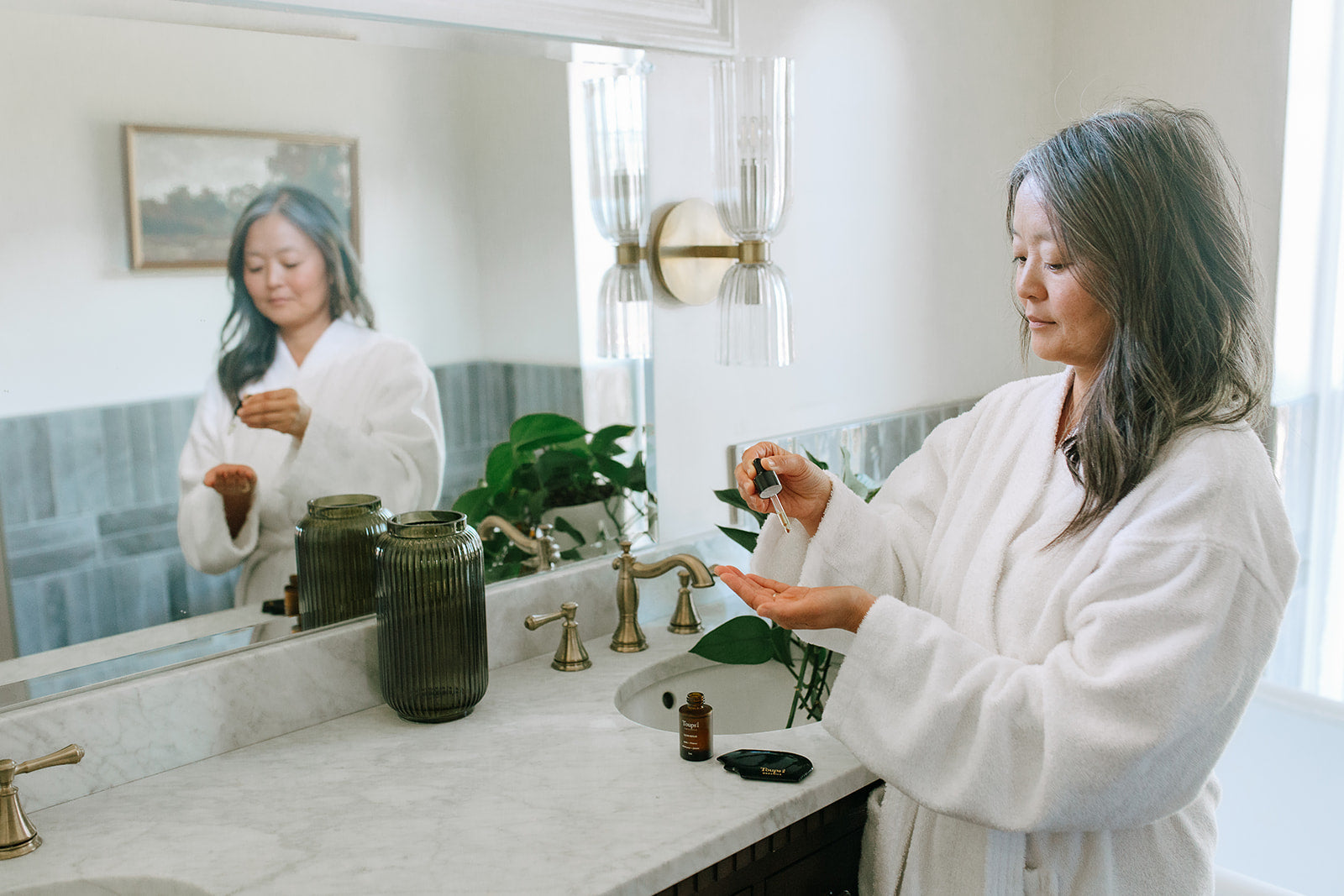You’re captivated by skincare that promises clearer and naturally smoother results. But when you try these products for yourself, they don’t clear your chronic acne breakouts. If this is your experience, you might be dealing with hormonal acne.
If you have a graveyard of skincare bottles hanging out in your bathroom cabinet, you might have chronic acne. And, you’re certainly not alone. Acne is one of the most common skin concerns, affecting around 85% of young adults.
Modern remedies for hormonal acne include: skincare products, dietary changes, and pharmaceutical medications. But these solutions don’t always work long term. Why not? Well, sometimes the root cause of acne is hormone imbalance — and that requires more internal work.
What Is Hormonal Acne?
Hormonal acne is caused by changes in your hormone cycle. It often shows up right before your period or during seasons of hormonal shifts (like pregnancy, postpartum, menopause, and puberty). Typically, hormonal acne appears on the chin, jawline, and cheeks. People who experience it report painful and cystic breakouts that don’t respond well to skincare alone.
What Causes Hormonal Acne?
As women, we have four different phases of the hormone cycle: menstruation, the follicular phase, ovulation, and the luteal phase. During these phases, different hormones rise and fall to support fertility.
These hormones are delicate and easily influenced by stress, hormone disruptors, and processed foods. Hormonal acne is a sign that essential hormones like estrogen, testosterone, and progesterone aren’t in perfect balance and need a little extra attention. For instance, high levels of testosterone in the body (characteristic of PCOS) can make our skin produce more oil, leading to more acne.
Hormonal acne doesn’t usually arrive on its own. Likely, you’ll experience other symptoms of hormone disruption, like painful periods, bloating, fatigue, mood swings, weight changes, brain fog, hair thinning, or sleep disturbances. Maybe hormonal acne is at the front of your mind, but these other symptoms can impact your quality of life, too. The goal when treating it is to help you feel better across the board.
Significant hormonal shifts are often connected to…
- Puberty
- Pregnancy and postpartum
- Menopause
- High stress levels
- An imbalanced nervous system
- Environmental hormone disruptors
- Hormone imbalances
- Hormone disorders (PCOS, thyroid disorders, Cushing's syndrome, or endometriosis)
What Does Hormonal Acne Look Like?
Hormonal acne has a few characteristics that make it easier to recognize. It usually shows up before or during your menstrual cycle, and breakouts happen on the cheeks, jawline, and chin. It can also appear during seasons of hormonal shift. Like regular acne, it can be influenced by environmental bacteria (from your pillowcase or makeup brushes), but removing this bacteria won’t fully resolve it.
Similarly, skincare products can only do so much for hormonal acne, since the root cause is internal. You might try the oil cleansing method, a detoxing cleanser, and a nourishing skincare routine to get some results, but this likely won’t eliminate breakouts fully.
Fungal Acne vs. Hormonal Acne
Fungal acne and hormonal acne have a lot of similarities. But it’s important to find out which one you have so you can target it. To tell the difference, pay attention to when your breakouts happen. Hormonal acne is more active during your period, while fungal acne can happen all month long.
If you have fungal acne, you likely have other symptoms of fungal issues, like yeast infections, candida overgrowth, skin rashes, fatigue, and mood swings. A GI-MAP and functional testing can help you tell the difference.
A Holistic Approach: Diet, Lifestyle, and Skincare Changes to Resolve Hormonal Acne
To truly address hormonal acne, we need a whole-body approach. Your diet, lifestyle, and skincare routine all play an equal role.
Diet
Some people notice that removing dairy or sugar makes a big difference in their hormonal acne (and this is often the first recommendation). This can be helpful, but it doesn’t always address the root cause of hormone imbalance and it’s somewhat outdated. We find that a more well-rounded approach keeps acne away long-term.
Our recommendation is to target gut health, liver health, and inflammation throughout the whole body. Prioritize skin-building foods like gelatin, collagen, minerals, fatty acids, protein, and fiber (although with fiber, always go slow!). Reduce your exposure to processed foods and seed oils, and start cooking from home often.
If you do want to eat dairy, make sure it’s high-quality (grass-fed, A2, and even raw dairy can be easiest on the skin). Notice how your body reacts to different food groups, especially around your period. Pay careful attention to food quality, sourcing fresh veggies and fruit from your local farmer’s market and trading in inflammatory flour for more nourishing options, like ancestral and freshly milled grains.
To address hormonal acne with diet, stick to these basic principles:
- No processed foods or seed oils
- Reduce inflammatory foods
- Focus on your gut microbiome and liver health
- Find higher-quality dairy and wheat products
- Try seed cycling
- Prioritize skin-building foods (like gelatin and minerals)
- Get a GI-MAP and functional test to help you find the right probiotics
Skincare
Finding the right skincare routine for hormonal acne can be tricky. Hormonal shifts can change how your body produces sebum, leading to oily skin and frequent breakouts. For this, we recommend the oil cleansing method (to rebalance oil production), a detoxing cleanser, and a mineral-rich moisturizer that doesn’t clog pores. Our customers also report positive results from the Reparative Serum and our herbal Facial Tonic for acne.
To address hormonal acne with skincare, stick to these basic principles:
- No pore-cloggers
- Pure formulas with minimal ingredients
- Highly nourishing formulas (with minerals, fatty acids, and other skin-building ingredients)
- No hormone disruptors
- Always patch test
- Give your skincare products time to work (4–6 weeks, minimum)
- Use ingredients that restore the skin barrier, skin microbiome, and balance sebum levels
Lifestyle
For your hormones to function optimally, you need to reduce stress in your environment and support your nervous system. If your daily routine includes three cups of coffee, tons of blue light exposure, high-intensity workouts, and heavy doses of stress, your body might prioritize recovering from these things and put hormone health on the back burner.
To resolve this, prioritize stress-managing activities and self-care. Take daily walks in the sunshine, practice morning meditation, and put your phone away before bed. If the stress is chronic, you may need to rewire your brain and create new neural pathways for healthier thought patterns.
Yes, it can be difficult to draw the connection between chronic stress and hormonal acne, but we promise it’s there. Chronic stress can boost inflammation levels and can block your healing progress, rapidly depleting mineral and nutrient stores that are used for hormone balance.
To address hormonal acne with lifestyle changes, stick to these basic principles:
- Practice meditation or brain retraining
- Reduce blue light exposure
- Create boundaries around stressful work or home environments
- Replenish lost minerals and nutrients with holistic supplements
- Exercise (and sweat) regularly for detox
- Prioritize sleep
- Reduce acne-causing bacteria in your environment (but build up your skin’s microbiome so it can handle a bit of exposure)
Natural Remedies for Hormonal Acne You Haven’t Tried Yet
Diet, lifestyle, and skincare are the main tools we use to reverse hormonal acne. But removing hormone disruptors, avoiding pore-clogging ingredients, and prioritizing liver and blood sugar health also play an important role.
Remove hormone disruptors from your environment
Estrogen dominance is one of the most common types of hormone imbalance, and it can lead to hormonal acne. Interestingly, estrogen is also the hormone that’s most often mimicked by chemical hormone disruptors. Products like laundry detergent, plastic food containers, makeup, skincare, shampoo, toilet paper, period products, and even stretchy fabrics contain these estrogen-imitating chemicals.
Prioritize your liver health
Your liver plays a critical role in hormone regulation. Not only does it produce and regulate different hormones, but the liver also metabolizes excess estrogen, sending it out of the body. If you have any type of inflammatory illness (or if you’ve lived with chemicals, mold, heavy metals, and environmental pollutants), your liver is likely overloaded. Producing, regulating, and metabolizing hormones may be set aside in favor of more essential functions.
To support your liver, prioritize gentle detox and nutrition. Eat cruciferous veggies, visit a sauna, reset your nervous system, get a lymphatic massage, and drink lemon water first thing in the morning.
Target blood sugar balance
Remember, insulin is a hormone, too. Blood sugar highs and lows are often connected to estrogen dominance, high cortisol, or high testosterone. As you work on daily habits to balance your hormones, make sure you’re caring for your blood sugar levels, too. Eat plenty of vegetables and protein at the beginning of your meal. Take regular walks or lift weights to improve insulin sensitivity. Homeopathic remedies can help, too.
Try functional testing
Unfortunately, there’s no one-size-fits-all solution to hormone imbalance. Your body responds to its environment in its own way, and what works for someone else might not work for you. Functional testing (like a GI-MAP, HTMA, or thyroid and hormone panel) can show you real data behind your hormonal acne. That way, you find a personalized solution that’s more specific and fast-acting than blindly throwing a dart at your symptoms.
Reduce pore-clogging ingredients
The comedogenic scale is the most popular tool for understanding which skincare ingredients clog pores. But this scale isn’t regulated, and since there isn’t an official source for it, it’s largely opinion-based. You can use the comedogenic scale as a quick reference, but your own reaction to patch-testing skincare is a better guide.
Ingredients We Always Recommend for Hormonal Acne
Witch hazel, grass-fed tallow, jojoba oil, and raw honey are powerhouse ingredients — and usually, our first recommendation for an acne-prone skincare routine.
- Witch hazel (try Facial Tonic)
- Grass-fed tallow (try the Frankincense Face Balm or Hydrating Tallow Stick)
- Aloe vera (try our Liquid Foundation)
- Raw honey (try the Resurfacing Face Mask)
- Jojoba oil (try the Seabuckthorn Cleansing Oil)
- Activated charcoal (try the Charcoal Face Bar)
- Bakuchiol (try our Reparative Serum)
- Vitamin C (try our Reparative Serum)
- Basil leaf (Facial Tonic)
Skincare Sets for Hormonal Acne
Your breakouts might seem stubborn and unpredictable. Maybe you’ve dealt with them for a long time and tried all the skincare products on the market. The frustration of hormonal acne is real, but your breakthrough isn’t as far away as you think. For many people, there’s often just one dietary, lifestyle, or skincare change that dramatically moves the needle. The only hard part is uncovering exactly what it is.
As you focus on your whole-body health, we want to give you an easy tool that gets you one step closer to clear skin. The Skincare Starter Set is our go-to skincare set for acne, designed to cleanse and restore the skin’s microbiome and balance sebum. From the outside, it helps resolve the excess oil that’s so common with hormonal acne. It also helps build healthy skin with nutrients from tallow and seabuckthorn.
Get Relief — Try the Skincare Starter Set

